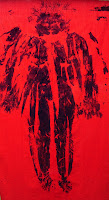Touching. To be touched - is it a physical sensation, a warm fuzzy feeling, or could it be a hurtful gesture? Who or what touches us? A lover, a stranger, a family member, an organization, a nation, a situation, a comment. If a lover and a hater can both touch us, could we then say that we are both voluntarily and involuntarily being touched? Are the sensations, thoughts and beliefs derived from these touching experiences out of our control? And the products, perhaps the writings and art works, of these experiences a conscious reaction?
Is the touching evident in the way she carries herself, worn like a shield on her breast? Does she wrap herself in a cloak to hide from these touchings only for them to be evident in and on the cloak itself? Does she run in flight from these touchings only to be haunted by them when she returns? Does the assistant know the extent of these touchings? Does she know she is part of the artist’s touching experience?

The Little Venus. Talparo, 2007.
Negative and positive energies are generated from these moments of touching, adding and subtracting from the initial touching experience. These touchings provide reference and context for the work. They may also be the work itself. Is the work then a conscious expression of the experiences? Or a facet, a by-product, a scar in the greater scheme off these touching experiences?
I often question whether one can really choose the work. I believe my work chooses me. My mind is conditioned by my touching experiences and the work can oftentimes acts as a problem solving mechanism. Then I wonder do I really have control over my work? Perhaps it is a mix of conscious effort and subconscious instincts that produce these intriguing objects. Could the relationship between experiences, the artist and the artwork be simplified into an equation?
an artist + a history of touching experiences = interesting work?
I think, quite possibly, yes.











